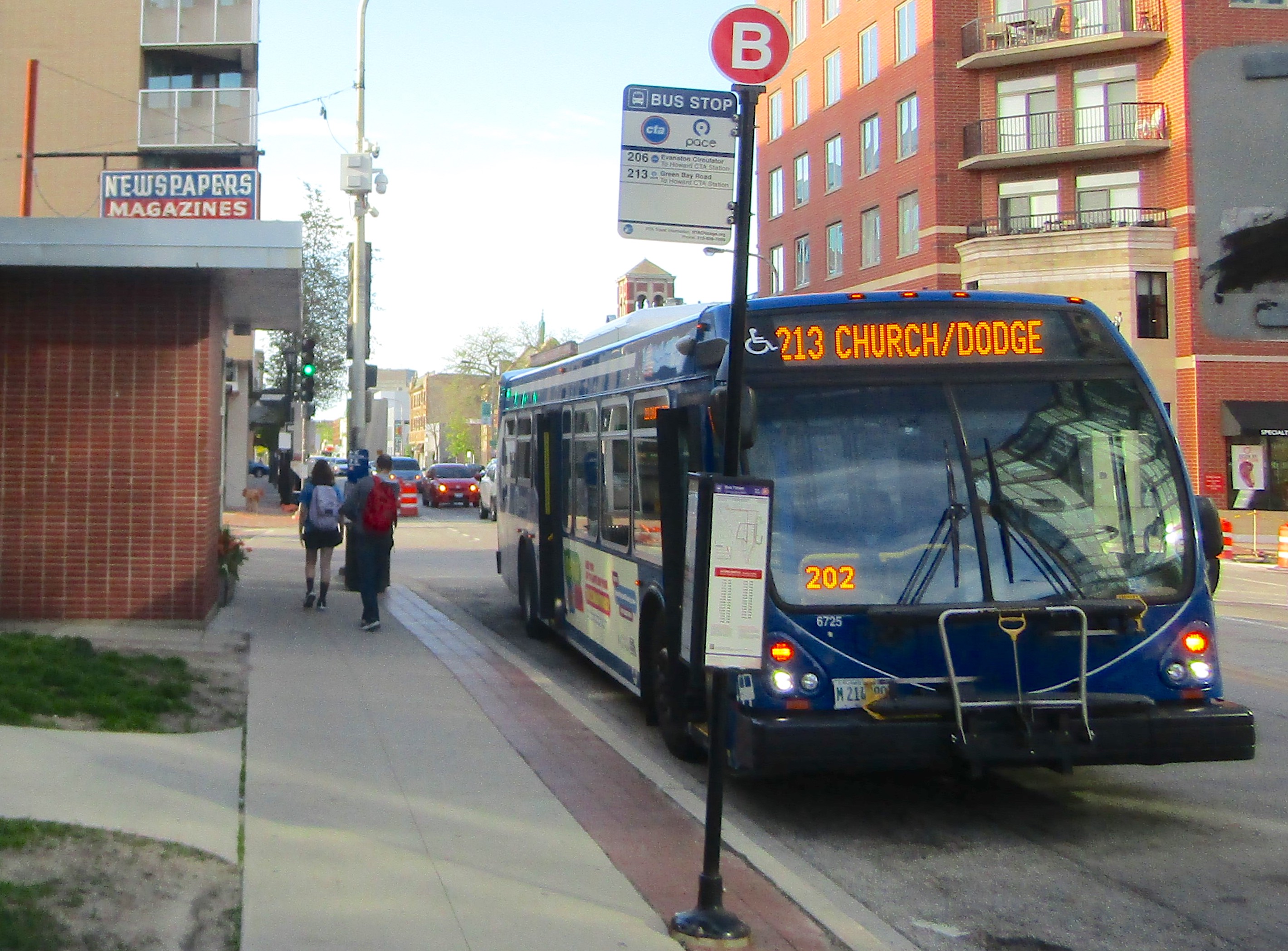As Pace suburban bus transit ridership continues to lag behind pre-pandemic numbers, it appears to be doing better in the north and northwestern suburbs than in the southern and western suburbs.
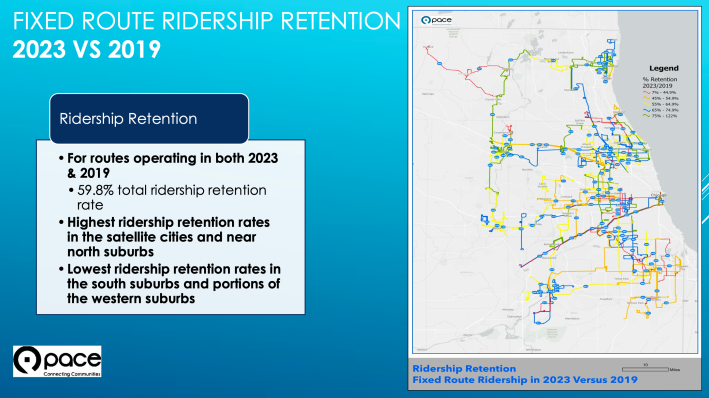
During the a recent meeting of the Pace board’s Joint Planning and Infrastructure Committee, Chief Planning Officer Erik Llewellyn gave a report on suburban ridership trends since COVID-19 hit. The report looked at fixed-route, paratransit, and dial-a-ride services alike, comparing the ridership numbers from 2019 and 2023. Llewellyn also discussed services has Pace launched since the pandemic.
The report showed that major corridor bus routes were the most successful lines in 2023 compared to 2019. However, commuter-orientated rush hour routes, whether local or express, tended to do worse.

In general, the south suburban routes experienced some of the worst ridership retention between 2019 and 2023. Paratransit in Chicago is basically at the pre-pandemic level, while paratransit in the suburbs is still lagging behind 2019 numbers.
In terms of post-pandemic service improvements, Llewellyn said the launch of Pace's Pulse - Dempster Line service was enough to catapult the Dempster Street corridor into one of the top five Pace ridership slots.

Route 697 - Northwest Transportation Center—Harper College, which was launched in August 2022, started off slow, but has seen an uptick in riders in 2023.
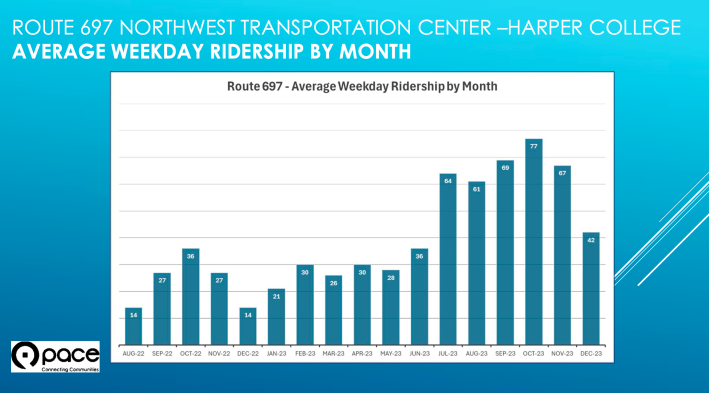
Pace’s last-mile pilots around O’Hare Airport and the Harvey Transit Center have been a mixed bag. While the former is doing well, the latter is performing below Pace’s expectations.
Pandemic Ridership Patterns
According to Llewelyn, Pace overall had recovered around 70 percent of its pre-pandemic ridership as of 2023.
Between 2022 and 2023, he said, systemwide ridership increased by 10.1 percent, but the improvements weren’t distributed evenly across the region. 82 percent of the routes saw increases, but a significant number saw decreases.
There doesn’t seem to be any kind of pattern. Many routes that saw ridership decreases have limited service, such as McHenry County’s Route 806 - Crystal Lake – Fox Lake and Route 808 - Crystal Lake – Harvard. But some traditionally busy corridor routes also saw decreases, such as north suburban Route 290 - Touhy Avenue.
However, when you compare pre-pandemic 2019 ridership and 2023 ridership, which Llewellyn called the rider retention rate, the patterns are more obvious, though there are still exceptions. Overall, suburbs that border Chicago and northern suburbs had a higher retention rate than southern suburbs and "portions" of western suburbs.
Unsurprisingly, routes that had service reductions, such as Route 209 - Busse Highway, and commuter routes, saw some of the lowest rider retention. That applies whether these routes served corporate campuses, such as Route 626 - Skokie – Buffalo Grove Limited, or United Parcel Service facilities, such as Route 890 - Chicago Heights – UPS Hodgkins Limited.
Llewellyn said that even before the pandemic, the ridership on shuttles to corporate campuses only accounted for around 5 percent of Pace’s overall ridership.
It's also interesting how the routes in major collar county cities fared. Most bus lines serving Elgin and Waukegan saw a 2019 to 2023 ridership retention rate of 65 percent or higher. Most Joliet lines had a roughly 65 percent retention rate. But most Aurora routes only had a 55-65 percent rate.
In addition, McHenry County’s Routes 807 - Woodstock – McHenry and Route 808 - Crystal Lake – Harvard saw low ridership retention rates. But Route 550 - Elgin Transportation Center – Crystal Lake and Route 806 - Crystal Lake – Fox Lake, which connect Metra's Milwaukee District West, Union Pacific Northwest and Milwaukee District North lines, had retention rates of over 75 percent.
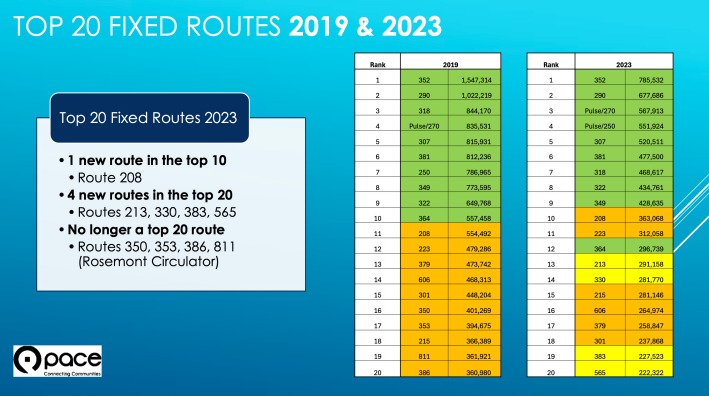
Llewellyn also discussed how Pace's list of the top 20 fixed routes has changed since 2019, fitting the general service retention pattern. Route 213 - Green Bay Road, which mostly runs parallel to the UP-N line in the North Shore suburbs, entered the top 20 for the first time.
So did Route 330 - Mannheim – LaGrange Roads and Route 383 - South Cicero, which provide north-south service along major west suburban corridors, and Route 565 - Grand Avenue which serves the Grand Avenue corridor in Waukegan and neighboring north suburbs. Llewellyn said Route 330 benefited from Pace adding a stop at the Rosemont Blue Line station.

Four routes dropped out of the top 20. Route 350 - Sibley, Route 353 - 95th/Dan Ryan CTA – River Oaks – Homewood Limited, and Route 386 - South Harlem are major south suburban corridors. Route 811 - Rosemont Entertainment Circulator, provides, as the name suggests, connects the village’s 'L' station to the surrounding hotels, convention centers, and shopping centers.
Llewellyn told the board that the change in rankings isn’t necessarily because some of the routes lost ridership, but because other routes gained it.
Service Improvements
Route 697 - Northwest Transportation Center—Harper College was launched to partially replace Route 696, which was eliminated during the pandemic. The new route provides service between the Northwest Transportation Center in Schaumburg and Harper College in neighboring Palatine. Unlike Route 696, it provides service to offices and industrial businesses along Algonquin Road.
Until June 2023, Route 697's ridership never went above 36 riders a day. But after that, the ridership settled into roughlt 60 rides a day, which Llewellyn attributed to more Harper students using the bus and a shift towards more in-person work in corporate offices. While the ridership is still below Route 696’s pre-pandemic 275 riders a day average, the increase was enough to get Pace to extend Route 697 beyond an initial year-long pilot.
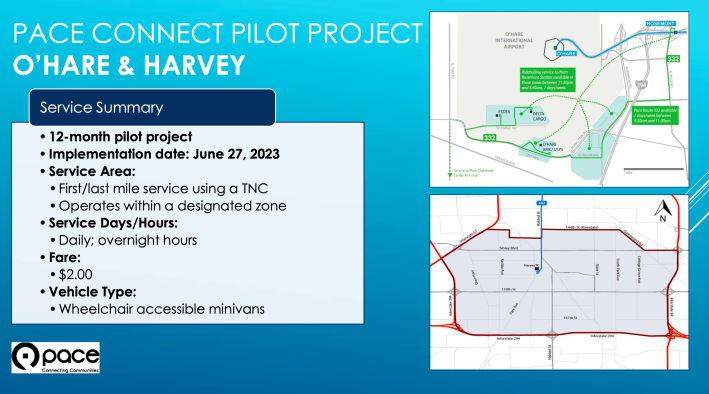
The Pace Connect pilot is part of the agency’s efforts to expand ride-hail options to provide last-mile connections. The plot focuses on the areas around O’Hare Airport and south suburban Harvey. Both zones get nighttime service via the Blue Line and Pace Route 352 – Halsted, respectively. But there isn't any local transit service to and from the 'L' and Route 352 for workers finishing or starting their shifts. Under the plot, riders can use ride-hail to fill in the gap and pay regular $2 Pace fares.
Llewellyn said that while ridership "gradually increased" in both the O'Hare and Harvey areas, it has been noticeably lower in the Harvey zone. In December 2023, Pace removed the requirement that the Harvey trips have to start or end at the local transit center in hopes of boosting ridership. Given that both areas saw Pace ridership increases in December, it’s not clear that eliminating that rule that had any effect on Harvey ridership. "We are continuing to evaluate this service and the effectiveness of the pilot project," he said.
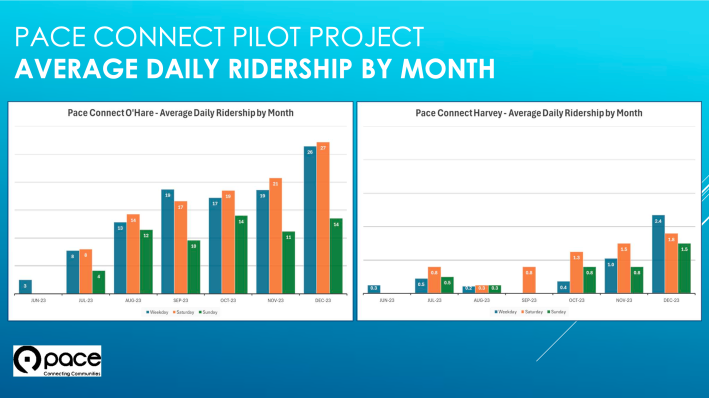
Pace board member Lindo Soto, who represents Lake County, suggested that there was an untapped market in that area. "Lake Country is having such a manufacturing boom. We have more coming in in the next year, and the demand for second and third shift transportation is there."
Board member Christopher Canning, who represents northern suburbs within Cook County, asked about increasing service to Endeavor Health Glenbrook Hospital in Glenview, which is getting a new state of the art heart health center. The hospital is currently served by Pace's Route 210 - Lincoln Avenue and Route 270 - Milwaukee Avenue, but Route 210 doesn’t operate on weekends. Llewellyn responded that Pace will look into increasing service to the hospital.
Pace Executive Director Melinda Metzger told the committee that she’s very conscious of the system deficiencies. She said more frequent and predictable service is key, but the challenge is having enough vehicles and drivers to operate it. "I truly believe we don't have enough service out there."
Metzger noted that Chicagoland has large gaps where there's no proper transit service, with an hour or longer between runs. "We need to get better headways, 15-20 minute headways, and then I think our ridership will [grow]. If people can rely on us, they will come."

Did you appreciate this post? Please consider making a tax-deductible donation.
